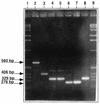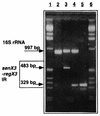Identification of a new DNA region specific for members of Mycobacterium tuberculosis complex
- PMID: 9542912
- PMCID: PMC104664
- DOI: 10.1128/JCM.36.4.937-943.1998
Identification of a new DNA region specific for members of Mycobacterium tuberculosis complex
Abstract
The successful use of DNA amplification for the detection of tuberculous mycobacteria crucially depends on the choice of the target sequence, which ideally should be present in all tuberculous mycobacteria and absent from all other bacteria. In the present study we developed a PCR procedure based on the intergenic region (IR) separating two genes encoding a recently identified mycobacterial two-component system named SenX3-RegX3. The senX3-regX3 IR is composed of a novel type of repetitive sequence, called mycobacterial interspersed repetitive units (MIRUs). In a survey of 116 Mycobacterium tuberculosis strains characterized by different IS6110 restriction fragment length polymorphisms, 2 Mycobacterium africanum strains, 3 Mycobacterium bovis strains (including 2 BCG strains), and 1 Mycobacterium microti strain, a specific PCR fragment was amplified in all cases. This collection included M. tuberculosis strains that lack IS6110 or mtp40, two target sequences that have previously been used for the detection of M. tuberculosis. No PCR fragment was amplified when DNA from other organisms was used, giving a sensitivity of 100% and a specificity of 100% in the confidence limit of this study. The numbers of MIRUs were found to vary among strains, resulting in six different groups of strains on the basis of the size of the amplified PCR fragment. However, the vast majority of the strains (approximately 90%) fell within the same group, containing two 77-bp MIRUs followed by one 53-bp MIRU.
Figures





Similar articles
-
Specific differentiation between Mycobacterium bovis BCG and virulent strains of the Mycobacterium tuberculosis complex.J Clin Microbiol. 1998 Sep;36(9):2471-6. doi: 10.1128/JCM.36.9.2471-2476.1998. J Clin Microbiol. 1998. PMID: 9705376 Free PMC article.
-
[Study on detection of the Mycobacteria DNA in formalin-fixed, paraffin-embedded tissue samples by triplex polymerase chain reaction].Wei Sheng Wu Xue Bao. 2002 Feb;42(1):69-75. Wei Sheng Wu Xue Bao. 2002. PMID: 12557351 Chinese.
-
A novel polymorphic genetic locus in members of the Mycobacterium tuberculosis complex.Microbiology (Reading). 1999 Jul;145 ( Pt 7):1695-1701. doi: 10.1099/13500872-145-7-1695. Microbiology (Reading). 1999. PMID: 10439408
-
Assessment of genetic markers for species differentiation within the Mycobacterium tuberculosis complex.J Clin Microbiol. 1996 Apr;34(4):933-8. doi: 10.1128/jcm.34.4.933-938.1996. J Clin Microbiol. 1996. PMID: 8815111 Free PMC article.
-
Identification of novel intergenic repetitive units in a mycobacterial two-component system operon.Mol Microbiol. 1997 Dec;26(5):991-1003. doi: 10.1046/j.1365-2958.1997.6361999.x. Mol Microbiol. 1997. PMID: 9426136
Cited by
-
Molecular characteristics of strains of the cameroon family, the major group of Mycobacterium tuberculosis in a country with a high prevalence of tuberculosis.J Clin Microbiol. 2004 Nov;42(11):5029-35. doi: 10.1128/JCM.42.11.5029-5035.2004. J Clin Microbiol. 2004. PMID: 15528691 Free PMC article.
-
Use of the hupB gene encoding a histone-like protein of Mycobacterium tuberculosis as a target for detection and differentiation of M. tuberculosis and M. bovis.J Clin Microbiol. 2004 Jun;42(6):2724-32. doi: 10.1128/JCM.42.6.2724-2732.2004. J Clin Microbiol. 2004. PMID: 15184459 Free PMC article.
-
Proposal for standardization of optimized mycobacterial interspersed repetitive unit-variable-number tandem repeat typing of Mycobacterium tuberculosis.J Clin Microbiol. 2006 Dec;44(12):4498-510. doi: 10.1128/JCM.01392-06. Epub 2006 Sep 27. J Clin Microbiol. 2006. PMID: 17005759 Free PMC article.
-
A single-step sequencing method for the identification of Mycobacterium tuberculosis complex species.PLoS Negl Trop Dis. 2008 Jun 18;2(6):e253. doi: 10.1371/journal.pntd.0000253. PLoS Negl Trop Dis. 2008. PMID: 18618024 Free PMC article.
-
Molecular epidemiology of tuberculosis: current insights.Clin Microbiol Rev. 2006 Oct;19(4):658-85. doi: 10.1128/CMR.00061-05. Clin Microbiol Rev. 2006. PMID: 17041139 Free PMC article. Review.
References
-
- Barnes P F, Bloch A B, Davidson P T, Snider D E., Jr Tuberculosis in patients with human immunodeficiency virus infection. N Engl J Med. 1991;324:1644–1650. - PubMed
-
- Bloch A B, Cauthern G M, Onorato I M, Dansbury K G, Kelly G D, Driver C R, Snider D E. National survey of drug-resistant tuberculosis in the United States. JAMA. 1994;271:665–671. - PubMed
-
- Bloom B R, Murray C J L. Tuberculosis: commentary on a reemergent killer. Science. 1992;257:1055–1064. - PubMed
Publication types
MeSH terms
Substances
LinkOut - more resources
Full Text Sources
Other Literature Sources
Molecular Biology Databases

